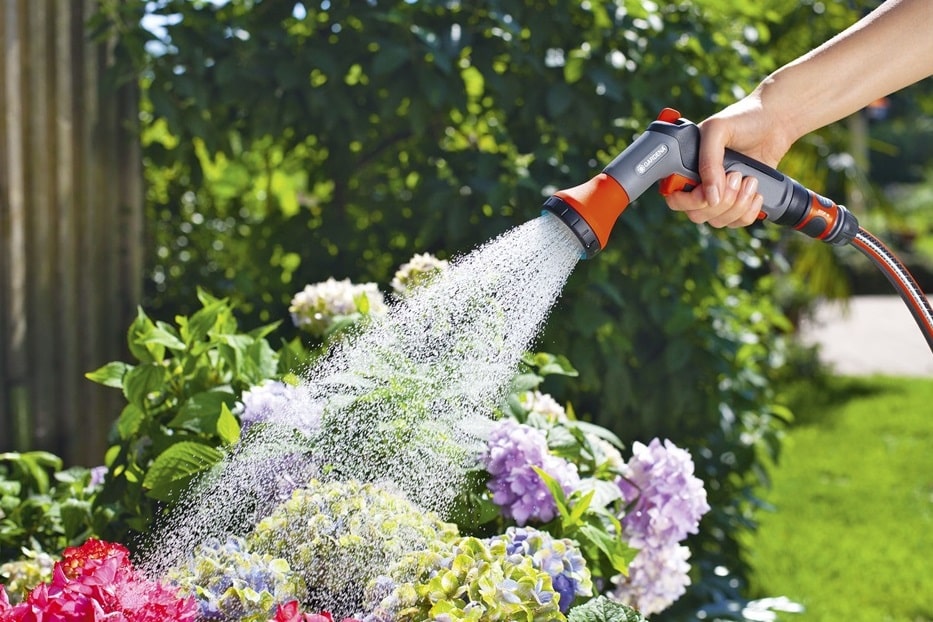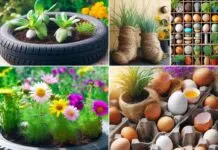
Most of the garden plants have an incredible ability to keep themselves cool. But it is extremely important to know how much water does the garden need.
Basically, moisture from the soil is taken in through the plant’s roots and pushed out through its leaves, creating an ongoing cooling effect (transpiration).
So long as there is adequate moisture in the soil, the leaves on a healthy sun-loving plant should not become scorched.
On a normal mild summer’s day, a well-grown tomato plant is likely to use four to six liters of water a day.
However, when temperatures spike, water use also spirals and the tomato plants may use 8-12 liters to avoid stress.
Similarly, a medium-sized fruit tree with an average crop, two to three weeks away from harvest, may use 100 to 300 liters of water a day under normal conditions but soak up double this amount under high heat.
Most determine their plants’ water needs on a time basis – sprinklers set to run for 20 minutes twice a week or drippers for two hours once a week.
However, it is far more efficient to identify how many liters different plants need on a daily or weekly basis.
The amount of moisture absorbed by a healthy plant can be two to four times greater than one struggling. In this case, the plant will use more water, but it will be in a much sounder position to keep itself cool.
When you water by time, it is important to realize the amount of water available from these systems varies considerably.
-
Standard dripper hose: Two liters per hour
-
Pressure compensating trickier: 25 liters per hour
-
Lo Flo sprinkler: 300 liters per hour
-
Standard (hole in the center) sprinkler: 1500 liters per hour
In this case, the time needed to water the tomato plant, referred to earlier, will vary dramatically.
The key to preventing heat stress during extended hot weather is to make sure there is plenty of moisture in the plant’s root system at all times.
In most situations, but not all, watering more often is far more efficient and effective than retaining your existing watering frequency but watering for a longer period.
The aim, when watering, should be to apply enough water to soak the plant’s root zone. If your water longer, much of the additional moisture will soak below the root system and be lost.
On the other hand, watering more often will return moisture to the root zone before reserves are depleted.
As a general rule, plants with a shallow root system – vegetables and flowers – need more frequent watering than those with a deep root system, such as large shrubs and trees.
After three or four days of above-average temperatures, soil moisture levels within the root zone will be very low and unless significant rain is forecast, it should be restored quickly.
Water and Harvests
Watering is not limited to bringing to a plant its water ration, it is necessary to optimize this contribution by providing at the right time (at the cool hours), in the right way (without wetting the foliage) and in good quantity (walnut the plant is useless). Water well, it is both good feed the plant, and saves water, a precious commodity among all. Whether it’s watering a simple flower bed or a vegetable garden, an entire garden, or farmland, there are solutions adapted to each configuration.
Watering Methods
Depending on the surface, the shape, and the destination of the plots to be watered, it is advisable
to choose from different techniques:
-manual irrigation;
-sprinkling;
-micro-irrigation;
-irrigation.
Manual irrigation
– with a watering can or a pipe – is the most frequently used in the garden’s vegetable. Its limit is obviously the size of the plot to irrigate. Watering by sprinkling allows him to water regularly and without fatigue flower garden beds, beds, or lawns. For this, it is possible to use an oscillating, rotating sprinkler, or nozzles. Micro-sprinkling, a water-saving variant, is particularly adapted to flower beds.
In addition, irrigation by micro-irrigation (or drip) provides plants a slow and precise supply of water, which nourishes the roots directly; while irrigation is used mainly on a large scale, that is to say for agricultural land.
Water is essential for plants, but it’s also A resource valuable that becomes rare. irrigating your garden well is
learn to use the least possible water with efficiency Max.
From manual watering to fully automated watering, going through the timer-assisted devices, the range of solutions is extended. The simplest method is obviously manual. This watering by hand gardening tools requests for more garden equipment: a watering can or a garden hose finished by a lance or a pistol is enough. Their manipulation is childish, but these basic gestures will gain in effectiveness if they are performed at a good time, in the right way, and at the right frequency.
Read More: Qualities You Need to Look For in a Water Filtration Systems
Automatic Watering
An automatic watering system in the garden is nothing but a device controlled by a programmer, which triggers days and hours, for a programmed duration and without human intervention, irrigating your land. The programmer can then pilot a very simple installation (including a balcony) or a complex buried network. And the installation can work at normal pressure (spraying with sprinklers) or low pressure (watering by micro-irrigation or micro-sprinkling).
Water supply
These days, everything invites us to save the water. That is why, before any purchase of a system watering, you have to ask the question of diet in water from your future device. In addition to that provided by the public transmission network of water, it is possible to recover and then use the water supplied by the rain, a pond, or a well existing. If you have a big garden, it might even be interesting to drill to get free water at will. Wherever it comes from, this water must, however, be exploitable for watering: this is the role of the irrigation pump.
The installation
Different automatic systems can settle on the surface and without pipeline work. This is not the case, however for buried systems, which claim their works a lot heavier.
These include: spray sprinkler with programmer, micro-spray irrigation with programmer, porous pipe with a programmer, drip with a programmer. For a system of surface, just add a “nose-of-tap” programmer that will drive automatically install. This will allow the passage of water in a system by spraying, micro-sprinkling, or drip. In addition, before considering the installation of automatic watering, it is essential to check the available flow and water pressure.
How to Water your Garden?
Watering cleverly executed benefits both the plants, the planet, and your wallet. While some principles make sense, others, less known, are worth recalling.
Irrigation Gardener’s tips
When we water often, but superficially, the system root of plants tends to develop superficially rather than in-depth, while the water is precisely in-depth! It is why it is better to water in two passages, in starting with a light watering that moistens the earth; at the second watering, water penetrates better into the soil.
From sowing to harvesting: Care of Crops
Watering
If it rains regularly, the family garden does not need watering, except at the time of sowing and transplanting. In the dry season cultivate preferably vegetables that require little water, such as sorrel Guinea and perennial vegetables. The water of irrigation is generally measured in millimeters (mm): 1 mm = 1 liter per square meter = 1 watering can (about 10 liters) per 10 square meters. Water requirements depend on climate and soil.
During the dry season, if it does not rain, leafy vegetables have a need at least 6 mm of water a day and other vegetables from minus 4 mm per day, which is to say respectively 6 and 4 watering cans per board of 10 m2. Sandy soil should be watered more often than silty soil or clay because the sand holds a lot less well moisture. Watering heavy soils should be done more slowly to allow water to enter the soil. Avoid too much water: this displaces air from the soil and the roots may rot if the soil remains soaked for a long time.
After transplanting, the plants require daily watering lightweight. For plants more robust: about a watering per week on soils heavy and twice (or three once in hot conditions and dry) per week on light soils. Water preferably at the end afternoon. Avoid doing it in full sun to avoid a large loss of water by evaporation. Use a watering can with an apple in the nursery: the waterfalls in the fine rain and does not do not wash the floor. We can also use a broom and a bowl or a calabash filled with water.
Water Well-Spaced Plants
Water well-spaced plants (tomato, aubergine, cabbage, pepper, cucumber) near the foot, for example using a watering, can without the apple. Avoiding wetting the leaves reduces the risks of spreading diseases. It decreases the workload, so it can be easily filled the barrel, at a tap for example. In addition, it saves water, minimizing losses due to irregular watering, evaporation, and runoff. If surface irrigation is possible, apply local methods of immersion boards or Irrigation of furrows in ridges.
Other Crop Care Shelters
Shelters are used to protect seedlings and freshly transplanted plants sun and heavy rain. The most common shelters are composed of a roof of leaves or woven straw, placed on stakes, above the nursery. Shelters are sometimes covered with sheets of transparent plastic (polyethylene) to keep the plants dry, for example, to reduce the spread of tomato diseases during the wet season. We also install individual shelters using palm leaves
Weeding
Weeds compete with crops for light, water, and nutrients. Most of them grow quickly and suffocate easily the seedlings. Climbing weeds or green manures, such as kudzu or desmodium, quickly invade young trees. If trees have been covered to protect them from the sun, we may not be able to spot the problem in time.
Hand pulling and weeding are common methods. We pass a hoe well-sharpened under the surface of the ground. It is an ideal tool to cut weeds right after germination, as a condition that the soil is dry. The most important herbs snatch by hand or with a hoe, getting enough deep to avoid they do not grow back. In dry weather and sunny, let the herbs dry on the spot. Can also pick them up and drop them on compost, or under a tree to serve as the mulch.
Weeds that spread through stolons underground (eg Imperata that is harmful) or tubers (Nutgrass – Cyperus) are hard to fight. A fork will be without a doubt necessary to tear off the underground parts, but it will several strokes of the fork or hoe all around these plants for succeeding in rooting out and destroying them. Mulching is not enough to eliminate this kind of plant. Herbicides are too expensive and dangerous (crop damage, toxic to humans) for use in the family garden.
Staking and size
If the plants are fragile (tomato, aubergine), they are tied loosely to a picket that will help them bear the weight of their fruits. Climbing plants (several beans, basil, bitter cucumber) cling to any medium: branches dead planted in the ground, stakes (live) or lattice (chayote, a fruit of passion).
Picking up young shoots of grasses, shrubs, or trees for the meal is to cut them. In principle, new shoots buds below the cut point, which allows quickly to pick it up again. To obtain a single rod of a tomato plant, just pinch the little side shoots after their appearance. In this case, we remove the shoot in its entirety, without leaving a bud so that only one stem remains.
Harvest
Ideally, you can pick up vegetables, young shoots, or other vegetables every day and throughout the year. The harvest of leafy vegetables and young shoots should preferably be early morning. It is advisable to watch the time: fruits and vegetables picked up dry are better than wet products. Do not wash eggplant, tomato, and cucumber only immediately before consumption. Once washed, they rot quickly. Keep the vegetables and fruits in a dry, cool, airy, and dark place.
Advice on Efficient Watering
Watering is necessary during the hot season. But as water has become expensive and rare, it must, therefore, be used efficiently and economically.
Here are Some Watering Gardening Tips:
- Water as late as possible in the evening as the soil will be cooler, thus reducing evaporation in contact.
- You should be more attentive to young plants, as they need more regular watering than older ones.
- Plants in pots or trays need watering almost every day during very hot weather. Water slowly so that the substratum soaks up the water properly.
- If your soil is heavy, water less often but abundantly, as heavy soil keeps humidity for a long period. If the soil is light, water more often as the water doesn’t stay long.
- Allow plants to thirst a little between waterings so that the root system develops deeper in the soil. Watering on the surface encourages roots to develop on the surface, leaving them more exposed to drought.
- Avoid watering the leaves of plants subject to cryptogamic diseases like rose bushes, tomato plants, or members of the melon family in the vegetable garden.
- If the soil is compact, hoe the foot of the plants. Water will penetrate deeper into the soil. ‘A good hoeing is worth two waterings’ as the saying goes. This advice also applies to garden boxes.
- Get rid of weeds, which compete with your plants for water.
- To avoid evaporation of water, mulch your soil with pine bark, grass clippings, paper, or cardboard. Mulching will protect your soil from sunlight (which heats the soil) and will help retain the humidity underneath. It will also stop the development of weeds. It is equally efficient in pots and trays exposed to sunlight.
Did you Know?
- About half of all water used during the Summer is used to water lawns, gardens, and vegetable patches.
- A lawn sprinkler that sprays 19 liters of water per minute uses one and a half times as much water in one hour as 10 toilet flushes, 2 five-minute showers, 2 dishwashing cycles, and a big clothes wash.
- The human body loses 2,4 liters of water per day. The human being replaces this partly by drinking and the rest by eating.
for more information watch this video:












